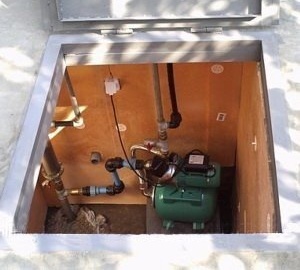Water supply system for a private house from a well: work procedure
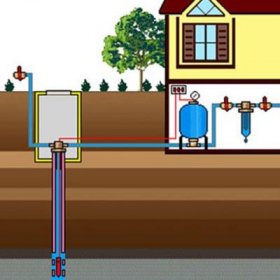
In case of unsatisfactory operation of the central water supply system or its complete absence in the village, it is possible to establish uninterrupted supply of a private house with water from a well drilled on the site.
Content
How to equip water supply at home - a phased description
Companies that provide well drilling services do not further develop them. All necessary work can be carried out independently by purchasing the necessary equipment and materials for laying the pipeline network from the source to the house on the market or in a specialized store. You will have to choose a pump, PND 32 pipes, a hydraulic accumulator to maintain the necessary pressure in the system, shut-off valves, etc.
Well drilling
Typically, a well breaks through in a local area. Depth, as a rule, varies in the range of 25-50 meters, deeper ones are expensive and require special permission to work. After the completion of drilling work, a pipe sticks out above the earth's surface, the diameter of which is from 100 to 159 mm. If the groundwater lies below a two-meter mark from the ground level, then equip the well. In other cases, it is necessary to build closed insulated outbuildings, allowing to establish constant maintenance at any time of the year.
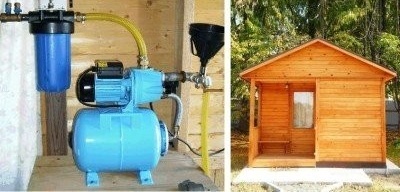
Well arrangement in a house specially built from timber, brick and cinder blocks. Dry insulated construction allows you to organize maintenance of a source of clean water
The dimensions of the well and the extension should allow for work to change the pump, to clean the well when such a need arises. You can build a small utility room from cinder blocks or bricks. All walls around the perimeter, as well as the floor and ceiling, must be insulated with polystyrene plates, the thickness of which should be at least 100 mm. In severe frosts, the heating cable that wraps around it will help to prevent freezing of water in the supply pipe. In order to prevent surface water from entering the borehole pipe, it is raised above the ground by 40 cm and closed with a head that protects the source of water intake from debris and dust.
With a low occurrence of groundwater, it is better to hide the well in the well. In this case, the earth itself acts as a heater. The deeper the well, the warmer it will be in it in the winter season. At the same time, the structure should also be insulated, and the water pipe is entwined with a heating cable.
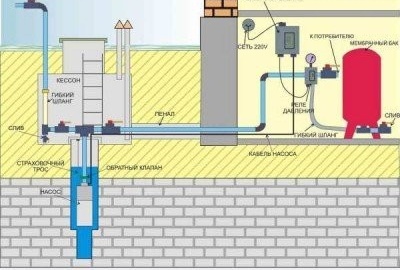
The arrangement of an aquifer in a well, otherwise called a caisson, allows you to use the heat-insulating properties of the earth as a natural insulation
Water pipe
When laying the pipeline, make sure that it lies below the level of soil freezing in the area. To do this, they dig a trench of the required depth and put a 32-mm pipe made of metal-plastic or cross-linked polyethylene at its bottom. A pipeline of these materials can be replaced with an HDPE pipe, but it is undesirable, since it can be destroyed during freezing.
Important! Remember that water cannot be supplied through hoses, so do not use them to lay pipelines.
A pipe laid below the freezing ground may be frostbitten at the lifting points. You can get rid of this problem by warming the foundation of the house, using heat insulating materials for wrapping the pipe itself, as well as laying along it a self-regulating heating cable.
If it is impossible to carry out excavation work on the site for any reason, or even be too lazy to do it, then you can let the pipeline run upstairs, slightly buried it in the ground. At the same time, the pipe is laid only together with a self-regulating heating cable. Additionally, the pipe is insulated with Energoflex or other similar materials. To preserve the insulating properties, the whole cake is placed in a sewer or special corrugated pipe of a larger diameter. At the same time, a storage tank is added to the system to water plants with warm water, which beneficially affects the growth of all crops.
Important! Together with the water pipe, the power cable of the pump is also laid. The electric wire must be four-core with a cross section of 2.5 and above. The power supply box (ROM) is installed in a warm room, specially allocated in the house.
Pump selection and installation
Two types of pumps can provide good trouble-free operation of the water supply system: rotary submersible or centrifugal. The most commonly purchased borehole submersible rotary pump of suitable capacity. When choosing a pump, a number of parameters are taken into account:
- well depth;
- highest point of water consumption;
- minimum column of water;
- total water consumption.
When buying a pump, pay attention to the following technical specifications:
- pump head, indicated by the manufacturer in meters (shows what pressure force the blades create in order to push water);
- pump flow rate, indicated in cubic meters per hour (shows the volume of fluid that the pump can pump per unit time).
The level of electricity consumption depends on the magnitude of its pressure and flow. The higher these specifications, the more energy is consumed during equipment operation. With increasing water consumption, the pressure will drop. By minimizing losses in the pipeline, it will be possible to optimize the operation of the pump, preventing its overload. The greatest demand is for pumps with a pressure of 60-80 meters, the flow rate of which reaches 4 meters cubic per hour.
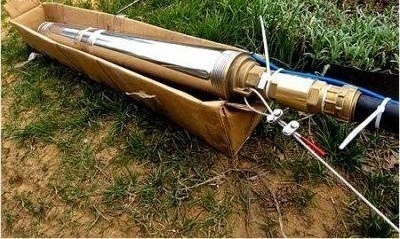
Well pumps vary in power, head, and capacity. They are used for pumping clean water not only from wells, but also from wells.
It is important to note that if there are interruptions in the power supply in the village or situations arise with a periodic voltage drop, then the pump must be connected through the stabilizer.
Video: how to choose downhole pumping equipment
See our other article on this topic: “How to choose a pump for a well: selection criteria and equipment classification«.
Features of installation of the unit
The collapsible “American 1 ″” connection will allow disconnecting the head from the borehole pipe together with the PND 32 water pipe and pump fixed with a steel 4 mm cable or 5 mm nylon thread.
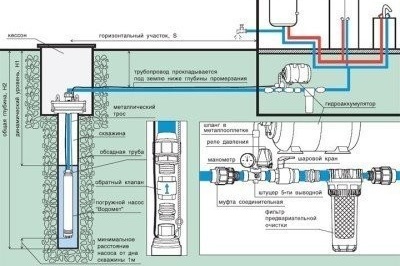
Installation of a submersible pump with an attached water supply pipe and a fixed steel cable is carried out with special care to prevent jamming of equipment
Using a cable, the pump is held at a certain distance from the bottom of the well, ranging from one to three meters. Leaving a greater distance is not recommended, as the equipment may become silty, which will make it difficult to climb upward or make this operation generally impossible. Installation of the check valve is carried out if this device is not provided in the design of the pump. The check valve allows you to prevent the reverse flow of water from the water supply to the well.
Before the descent, the PND 32 pipe is connected to the pump and the cable is hooked. Put the lower part of the head, equipped with sealing rubber, on the borehole pipe. They begin to slowly lower the pump, fixing every one and a half meters the power cable to the pipe using plastic clamps. At the same time, it is not worth pulling the cable strongly, otherwise it can break if the polypropylene pipe is stretched. The pump is lowered to the bottom, after which it is lifted one or two meters. In this position, the equipment is fixed by fixing the cable. Then fix the upper part of the head.
Scheme of serial connection of system elements
According to this scheme, a water supply device is carried out when water is supplied from the well.
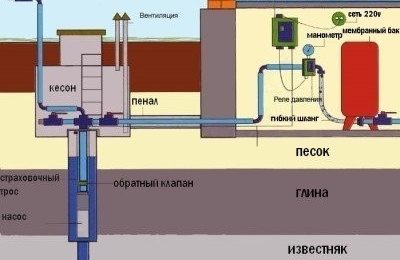
One of the most common schemes for organizing a water supply system in a private house, providing water under the necessary pressure for the operation of all plumbing equipment
Below are the main elements of an autonomous water supply system with a brief statement of their purpose:
- accumulator necessary to create a reserve of water and maintain an acceptable pressure level in the system;
- pressure switch allows you to adjust the on and off power of the well pump;
- the dry year relay is responsible for shutting down the pump in the event of water loss in the well;
- ROM (start-up protection device) is included with the pump;
- coarse filter protects the system from large particles polluting the water;
- a flask with an integrated cleaning cartridge provides a more thorough filtration of water;
- a pressure gauge is needed to control the pressure level.
As you can see, water supply from the well can be done with your own hands, but you must take into account too many nuances. Before carrying out work, you should familiarize yourself with the technology of their implementation. Perhaps the involvement of specialists will help to solve this problem faster and better.

